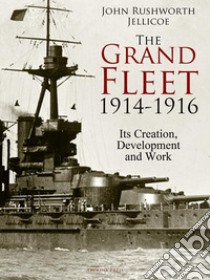The Grand Fleet, 1914-1916: Its Creation, Development and Work. E-book. Formato Mobipocket - 9788826459684
di John Rushworth Jellicoe
edito da ARCADIA PRESS , 2017
Formato: Mobipocket - Protezione: nessuna
€ 0.99
The Grand Fleet was the main fleet of the British Royal Navy during the First World War.
It was formed in August 1914 from the First Fleet and elements of the Second Fleet of the Home Fleets and it included 35–40 state-of-the-art capital ships. It was initially commanded by Admiral Sir John Jellicoe. He was succeeded by Admiral Sir David Beatty in December 1916.
The Grand Fleet was based first at Scapa Flow in the Orkney Islands and later at Rosyth on the Firth of Forth and took part in the biggest fleet action during the war – the Battle of Jutland – in June 1916.
In April 1919 the Grand Fleet was disbanded, with much of its strength forming a new Atlantic Fleet.
Not all the Grand Fleet was available to put to sea at any one time, because ships required maintenance and repairs. At the time of the battle of Jutland in May 1916 it had 32 dreadnought and super-dreadnought battleships. Of these 28 were in the Order of battle at Jutland.
The order of battle of the Grand Fleet at the end of the war appears in the Naval order of 24 October 1918.
The actual strength of the fleet varied through the war as new ships were built and others were sunk, but the numbers steadily increased as the war progressed and the margin of superiority over the German fleet progressed with it. After the United States entered the war, United States Battleship Division Nine was attached to the Grand Fleet as the Sixth Battle Squadron, adding four, and later five, dreadnought battleships.
Admiral of the Fleet John Rushworth Jellicoe, 1st Earl Jellicoe, GCB, OM, GCVO, SGM, DL (1859–1935) was a Royal Navy officer. He fought in the Anglo-Egyptian War and the Boxer Rebellion and commanded the Grand Fleet at the Battle of Jutland in May 1916 during the First World War.
His handling of the fleet at that battle was controversial: he made no serious mistakes and the German High Seas Fleet retreated to port – at a time when defeat would have been catastrophic for Britain – but the British public was disappointed that the Royal Navy had not won a victory on the scale of the Battle of Trafalgar. Jellicoe later served as First Sea Lord, overseeing the expansion of the Naval Staff at the Admiralty and the introduction of convoys, but was relieved at the end of 1917. He also served as the Governor-General of New Zealand in the early 1920s.
It was formed in August 1914 from the First Fleet and elements of the Second Fleet of the Home Fleets and it included 35–40 state-of-the-art capital ships. It was initially commanded by Admiral Sir John Jellicoe. He was succeeded by Admiral Sir David Beatty in December 1916.
The Grand Fleet was based first at Scapa Flow in the Orkney Islands and later at Rosyth on the Firth of Forth and took part in the biggest fleet action during the war – the Battle of Jutland – in June 1916.
In April 1919 the Grand Fleet was disbanded, with much of its strength forming a new Atlantic Fleet.
Not all the Grand Fleet was available to put to sea at any one time, because ships required maintenance and repairs. At the time of the battle of Jutland in May 1916 it had 32 dreadnought and super-dreadnought battleships. Of these 28 were in the Order of battle at Jutland.
The order of battle of the Grand Fleet at the end of the war appears in the Naval order of 24 October 1918.
The actual strength of the fleet varied through the war as new ships were built and others were sunk, but the numbers steadily increased as the war progressed and the margin of superiority over the German fleet progressed with it. After the United States entered the war, United States Battleship Division Nine was attached to the Grand Fleet as the Sixth Battle Squadron, adding four, and later five, dreadnought battleships.
Admiral of the Fleet John Rushworth Jellicoe, 1st Earl Jellicoe, GCB, OM, GCVO, SGM, DL (1859–1935) was a Royal Navy officer. He fought in the Anglo-Egyptian War and the Boxer Rebellion and commanded the Grand Fleet at the Battle of Jutland in May 1916 during the First World War.
His handling of the fleet at that battle was controversial: he made no serious mistakes and the German High Seas Fleet retreated to port – at a time when defeat would have been catastrophic for Britain – but the British public was disappointed that the Royal Navy had not won a victory on the scale of the Battle of Trafalgar. Jellicoe later served as First Sea Lord, overseeing the expansion of the Naval Staff at the Admiralty and the introduction of convoys, but was relieved at the end of 1917. He also served as the Governor-General of New Zealand in the early 1920s.
Ean
9788826459684
Titolo
The Grand Fleet, 1914-1916: Its Creation, Development and Work. E-book. Formato Mobipocket
Autore
Editore
Data Pubblicazione
2017
Formato
Mobipocket
Protezione
nessuna
Punti Accumulabili




